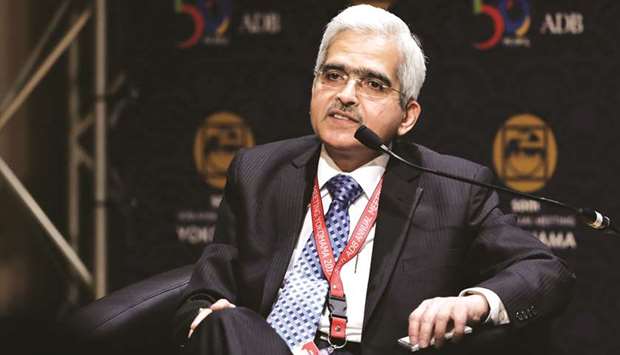Soon after taking over as India’s central bank governor almost a year ago, Shaktikanta Das decorated his 18th floor office overlooking the Arabian Sea.
Das, overseeing what was until recently the world’s fastest-growing major economy, has worked tirelessly to restore relations with the government after a bitter public spat led his predecessor Urjit Patel to quit. Colleagues say Das usually tucks papers under his arms at the end of the work day to continue plugging away from home.
He’s paid a hefty dividend to the finance ministry, swung into stimulus mode and eased up on bank lending restrictions – all of which Patel resisted in the face of government pressure. But there’s still much to do: the economy is losing steam on many fronts, the banking sector remains saddled with one of the world’s worst bad-debt loads and the government’s fiscal targets are slipping by the day.
Insiders say Das has turned around the mood in the bank’s Mumbai headquarters with an affable, plain-spoken approach. As one official said, he listens to everyone and then sticks to his own decision.
Among the RBI rank and file, the more academically-decorated predecessors of Patel and Raghuram Rajan were considered outsiders due to their long stints in American academia. Long-timers were put offside as in-house talent was often bypassed in senior appointments.
Rajan and Patel were contrasting personalities – Rajan the rockstar of global central banking and Patel reclusive both inside and outside the bank. Das strikes a balance. He has his own Twitter account and is more open to the media, giving interviews to local and foreign media including Bloomberg News. But he hasn’t taken to the global stage in the way Rajan did, such as when he led criticism of the Federal Reserve in 2014 for not taking into account the spillovers of its policies on emerging markets.
Das’s communication skills have helped improve the relationship with the government. The two sides no longer spar in public and instead resolve issues internally, finance ministry officials said. A recent example being the central bank’s reservations toward the finance ministry’s proposal for what would have been India’s first overseas sovereign bond issue. The proposal, which also met with opposition from within Prime Minister Narendra Modi’s own party, has been frozen.
The Reserve Bank of India has an out-sized role in the nation’s economy, making central bank-government friction a feature of policy making in the nation. Das is responsible for monetary policy, an exchange rate that’s near historic lows, supervising banks that carry one of the world’s biggest bad-debt loads, and selling bonds the government relies on to fund its yawning deficits. Most major central banks have only one or two of those duties.
Das, appointed on December 11 for a three-year term, set about changing course almost immediately. In one of his first decisions announced in early January, he instructed banks to restructure stressed loans given to small and medium-scale enterprises, thus breaking from a five-year-old policy of eschewing corporate debt overhauls. That was quickly followed up by lifting lending restrictions on three state-run banks.
In February, in his first meeting of the six-member monetary policy committee that he chairs, Das along with three other members voted for a 25 basis point interest-rate cut.
And in a sharp reversal from October last year, when the MPC led by Patel had taken rate cuts off the table, Das opened the door for more reductions and said reviving growth was the main priority of the inflation-targeting central bank. He’s cut five times this year, by a cumulative 135 basis points.
A test of Das’s ability to keep the government onside now presents itself given inflation has climbed back above the central bank’s medium-term target of 4%. The consumer price index bottomed out at 2% in January and was 4.6% in October. Despite the price revival, economists expect Das to stay in easing mode, and see the benchmark interest rate falling to 4.9% by the end of March 2020.
Das also heeded the government’s call for higher dividends, paying a record $24bn to government coffers in August. But the RBI’s pockets aren’t infinite and at some stage in the future Das may have to stare down any further requests for bumper payouts. Das is also in-charge of the exchange rate, and its management has in the past angered government officials and the export lobby, which complain about the rupee’s competitiveness. Das, like Patel, has reiterated the oft-repeated central bank approach that India’s exchange rate is market-driven and the RBI has no target in mind.
It’s the RBI’s role as regulator of the country’s banking system that creates the most potential for conflict with the government, because about 60% of the business is controlled by state-run banks. They are owned by the government and the RBI has limited supervision and legal powers to bring about changes in management to these banks, unlike the privately-owned ones where it holds more sway. That creates an uneven playing field leading to question marks over the efficacy of the central bank independence in regulating banks.
What really sets the RBI apart from many of its counterparts, especially in the west, is its role as the investment banker to the government. That creates potential for priorities in one realm to influence other areas of its mandate.
For instance, the RBI may be encouraged to keep interest rates low to help manage the government’s borrowing, even though inflation targets might come under threat, risking macro-economic and financial stability.

Shaktikanta Das: Managing multiple and conflicting roles.
